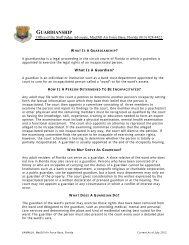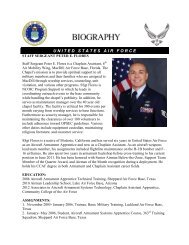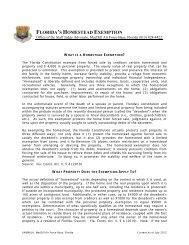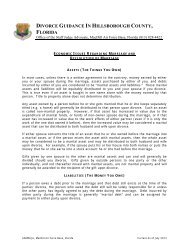History of MacDill - MacDill Air Force Base
History of MacDill - MacDill Air Force Base
History of MacDill - MacDill Air Force Base
You also want an ePaper? Increase the reach of your titles
YUMPU automatically turns print PDFs into web optimized ePapers that Google loves.
<strong>History</strong> <strong>of</strong> <strong>MacDill</strong><br />
1939 -- Present<br />
Above: An <strong>Air</strong>man trains with aircraft<br />
turret guns at <strong>MacDill</strong> Field for later duty<br />
on a B-17bomber during World War II.<br />
Above: Unit patches and a bomber jacket<br />
from the 307th Bombardment Group at<br />
<strong>MacDill</strong> in the early 1950s.<br />
Below: Two pilots leave the flightline with<br />
F-16 “Fighting Falcon” jets at <strong>MacDill</strong>.<br />
The base was home to fighter aircraft<br />
from 1962 up to 1993.<br />
<strong>MacDill</strong> <strong>Air</strong> <strong>Force</strong> <strong>Base</strong> is located seven miles south <strong>of</strong> Tampa, Florida, on the<br />
southwestern tip <strong>of</strong> the interbay peninsula in Hillsborough County. This area<br />
once had been used as a military staging area during the Spanish-American War<br />
but did not become a military installation until much later. In 1939, the War<br />
Department selected Tampa to receive one <strong>of</strong> several new military air fields and<br />
worked out arrangements for the transfer <strong>of</strong> the land.<br />
<strong>MacDill</strong> Field was <strong>of</strong>ficially activated on April 16, 1941, and named in honor<br />
<strong>of</strong> U.S. Army aviation pioneer and World War I veteran, Colonel Leslie <strong>MacDill</strong>.<br />
The first primary mission <strong>of</strong> the base during World War II involved training<br />
<strong>Air</strong>men to fly and operate bomber aircraft – such as the B-17 “Flying Fortress” or<br />
the B-26 “Marauder.” From 1942-45, many thousands <strong>of</strong> American men passed<br />
through <strong>MacDill</strong>’s gates to train as bomber pilots or crew members and then<br />
quickly move on to other military assignments, eventually destined for the deadly<br />
fight raging over Europe’s skies. Following the end <strong>of</strong> hostilities in Europe,<br />
<strong>MacDill</strong> began to train crews <strong>of</strong> the B-29 “Superfortress” in January 1945, which<br />
lasted through 1953.<br />
In January 1948, <strong>MacDill</strong> <strong>Air</strong> <strong>Force</strong> <strong>Base</strong> became an operational base for<br />
Strategic <strong>Air</strong> Command, and activities focused on training in the bombers <strong>of</strong> the<br />
early Cold War era. However, by 1960, the base faced an uncertain future. The<br />
Department <strong>of</strong> Defense announced it would close most <strong>of</strong> it by 1962 – due in part<br />
to the advent <strong>of</strong> the “missile age” that de-emphasized the bombers. However,<br />
hostilities with Cuba in the early 1960s highlighted the strategic location <strong>of</strong> the<br />
base and led to a reprieve <strong>of</strong> the planned cutbacks. During this time, <strong>MacDill</strong><br />
assumed another important role providing support for a prominent unified<br />
command, U.S. Strike Command, assigned to the base in 1961.<br />
In 1963, the bombers gave way to the fighters when <strong>MacDill</strong> became a<br />
Tactical <strong>Air</strong> Command training base. Throughout the Vietnam War and up until<br />
the first Gulf War in 1991, Tampa became a home for the F-4 “Phantoms” and<br />
later the F-16 “Fighting Falcons.” Between 1979 and 1993 approximately half <strong>of</strong><br />
all F-16 pilots trained at <strong>MacDill</strong>.
<strong>MacDill</strong> <strong>Air</strong> <strong>Force</strong> <strong>Base</strong><br />
The 6th Wing (1994 - Present)<br />
In 1991, the era <strong>of</strong> the fighters at <strong>MacDill</strong> began to wane. Due to military downsizing, the Defense<br />
<strong>Base</strong> Closure and Realignment Commission required the base to cease all flying operations by 1993. The<br />
action effectively transferred more than 100 F-16 fighters to Luke AFB, Arizona. When the last F-16s left<br />
the base in 1994, <strong>MacDill</strong> AFB had no active duty aircraft for the first time.<br />
In 1994, <strong>MacDill</strong> became home to the 6th <strong>Air</strong> <strong>Base</strong> Wing. This new wing had a primary mission <strong>of</strong><br />
operating the base in support <strong>of</strong> U.S. Central Command, U.S. Special Operations Command, and a large<br />
number <strong>of</strong> other mission partners and tenant units. However, this mission would grow. In 1994, <strong>MacDill</strong><br />
played a prominent role in U.S. operations to restore Haitian President Jean-Bertrand Aristide and his<br />
government after an attempted military coup. With operations in Haiti highlighting <strong>MacDill</strong>’s significance<br />
in the region, the 1995 Defense <strong>Base</strong> Closure and Realignment Commission recommended to retain the<br />
airfield under <strong>Air</strong> <strong>Force</strong> control. Eventually, this led to <strong>MacDill</strong>’s new mission in refueling.<br />
Left: A jumpmaster <strong>of</strong> U.S. Special Operations Command (at <strong>MacDill</strong>) directs parajumpers aboard a C-130 “Hercules.”<br />
Right: A model <strong>of</strong> the KC-135 “Stratotanker” greets visitors at the front gate <strong>of</strong> <strong>MacDill</strong> <strong>Air</strong> <strong>Force</strong> <strong>Base</strong>.<br />
In 2008, the base wing experienced more changes as part <strong>of</strong> a major restructuring by the <strong>Air</strong> <strong>Force</strong>. This<br />
time, <strong>MacDill</strong> and the 6th welcomed the <strong>Air</strong> <strong>Force</strong> Reserve’s 927th <strong>Air</strong> Refueling Wing as a joint partner<br />
in the aerial refueling mission at <strong>MacDill</strong>. Currently, these two units – one active duty and the other<br />
reserve – work together using the same KC-135 “Stratotankers” to more efficiently carry out the <strong>Air</strong><br />
<strong>Force</strong>’s missions. Today at <strong>MacDill</strong>, the 6 th <strong>Air</strong> Mobility Wing performs aerial refueling, airlift, and<br />
contingency response missions for U.S. and allied forces around the world. The wing has sixteen KC-135<br />
“Stratotankers,” three C-37A aircraft, and more than 2,700 personnel assigned. Additionally, the 6th <strong>Air</strong><br />
Mobility Wing is the host unit <strong>of</strong> <strong>MacDill</strong> <strong>Air</strong> <strong>Force</strong> <strong>Base</strong> and provides direct support to U.S. Central<br />
Command, U.S. Special Operations Command, and 39 other tenant units.<br />
Current: 1 Oct 2012
















